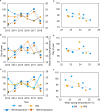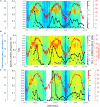What's all that racket! Soundscapes, phenology, and biodiversity in estuaries
- PMID: 32881856
- PMCID: PMC7470342
- DOI: 10.1371/journal.pone.0236874
What's all that racket! Soundscapes, phenology, and biodiversity in estuaries
Abstract
There is now clear evidence that climate change affects terrestrial and marine ecosystems and can cause phenological shifts in behavior. Utilizing sound to demonstrate phenology is gaining popularity in terrestrial environments. In marine ecosystems, this technique is yet to be used due to a lack of multiyear datasets. Our study demonstrates soundscape phenology in an estuary using a six-year dataset. In this study, we showed that an increase in acoustic activity of snapping shrimp and certain fish species occurred earlier in years with warmer springs. In addition, we combined passive acoustics and traditional sampling methods (seines) and detected positive relationships between temporal patterns of the soundscape and biodiversity. This study shows that passive acoustics can provide information on the ecological response of estuaries to climate variability.
Conflict of interest statement
The authors have declared that no competing interests exist.
Figures





References
-
- Root T. L., Price J. T., Hall K. R., Schneider S. H., Fingerprints of global warming on wild animals and plants (tier 2). Nature 421, 57–60 (2002). - PubMed
Publication types
MeSH terms
Substances
LinkOut - more resources
Full Text Sources

